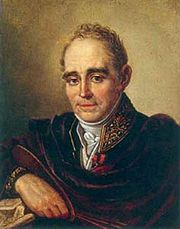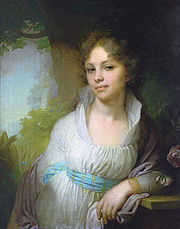
Vladimir Borovikovsky
Encyclopedia


Russian Empire
The Russian Empire was a state that existed from 1721 until the Russian Revolution of 1917. It was the successor to the Tsardom of Russia and the predecessor of the Soviet Union...
painter who dominated Russian portraiture at the turn of the 19th century.
Biography
Vladimir Borovikovsky was born Vоlоdymyr Borovyk in MyrhorodMyrhorod
Myrhorod or Mirgorod is a city in the Poltava Oblast of central Ukraine. Serving as the administrative center of the Myrhorodskyi Raion , the city itself is also designated as a separate raion within the oblast, and is located on the river Khorol.-History:The town was founded either in the 12th...
(now Ukraine
Ukraine
Ukraine is a country in Eastern Europe. It has an area of 603,628 km², making it the second largest contiguous country on the European continent, after Russia...
) on July 24, 1757. His father, Luka Borovyk was a Ukrainian Cossack
Cossack
Cossacks are a group of predominantly East Slavic people who originally were members of democratic, semi-military communities in what is today Ukraine and Southern Russia inhabiting sparsely populated areas and islands in the lower Dnieper and Don basins and who played an important role in the...
and an amateur icon painter. According to the family tradition, all four of Borovyk's sons served in Myrhorod regiment
Regiment
A regiment is a major tactical military unit, composed of variable numbers of batteries, squadrons or battalions, commanded by a colonel or lieutenant colonel...
, but Volodymyr retired early at the rank of poruchik
Poruchik
Poruchik was a military rank in several Slavic countries, such as the Russian Empire and the Republic of Poland, equivalent to Lieutenant. "Poruchik" means "messenger", "officer for orders". This is a Slavic copy of the term "Lieutenant" .In Russia this rank was first introduced in Strelets New...
and devoted his life to art — mostly icon painting for local churches.
Borovikovsky may have lived the remainder his life as an amateur painter in a provincial town if not for an unexpected event. His friend Vasyl Kapnist was preparing an accommodation for Empress Catherine II
Catherine II of Russia
Catherine II, also known as Catherine the Great , Empress of Russia, was born in Stettin, Pomerania, Prussia on as Sophie Friederike Auguste von Anhalt-Zerbst-Dornburg...
in Kremenchuk
Kremenchuk
Kremenchuk is an important industrial city in the Poltava Oblast of central Ukraine. Serving as the administrative center of the Kremenchutskyi Raion , the city itself is also designated as a separate raion within the oblast, and is located on the banks of Dnieper River.-History:Kremenchuk was...
during her travel to newly conquered Crimea
Crimea
Crimea , or the Autonomous Republic of Crimea , is a sub-national unit, an autonomous republic, of Ukraine. It is located on the northern coast of the Black Sea, occupying a peninsula of the same name...
. Kapnist asked Borovikovsky to paint two allegoric paintings (Peter I of Russia
Peter I of Russia
Peter the Great, Peter I or Pyotr Alexeyevich Romanov Dates indicated by the letters "O.S." are Old Style. All other dates in this article are New Style. ruled the Tsardom of Russia and later the Russian Empire from until his death, jointly ruling before 1696 with his half-brother, Ivan V...
and Catherine II as peasants sowing seeds and Catherine II as a Minerva
Minerva
Minerva was the Roman goddess whom Romans from the 2nd century BC onwards equated with the Greek goddess Athena. She was the virgin goddess of poetry, medicine, wisdom, commerce, weaving, crafts, magic...
) for her rooms. The paintings so pleased the Empress that she requested that the painter move to Saint Petersburg
Saint Petersburg
Saint Petersburg is a city and a federal subject of Russia located on the Neva River at the head of the Gulf of Finland on the Baltic Sea...
.
After September 1788 Borovikovsky lived in Saint Petersburg where he changed his surname from the Cossack "Borovyk" to the more aristocratic-sounding "Borovikovsky". For his first ten years in Saint Petersburg, he lived in the house of the poet, architect, musician and art theorist, Prince Nikolay Lvov
Nikolay Lvov
Nikolay Aleksandrovich Lvov was a Russian artist of the Age of Enlightenment. Lvov, an amateur of Rurikid lineage, was a polymath who contributed to geology, history, graphic arts and poetry, but is known primarily as an architect and ethnographer, compiler of the first significant collection of...
, whose ideas strongly influenced Borovikovsky's art. At 30-years-old, he was too old to attend Imperial Academy of Arts
Imperial Academy of Arts
The Russian Academy of Arts, informally known as the St. Petersburg Academy of Arts, was founded in 1757 by Ivan Shuvalov under the name Academy of the Three Noblest Arts. Catherine the Great renamed it the Imperial Academy of Arts and commissioned a new building, completed 25 years later in 1789...
, so he took private lessons from Dmitry Levitzky
Dmitry Levitzky
Dmitry Levitzky was a Russian-Ukrainian portrait painter.-Biography:...
and later from Austria
Austria
Austria , officially the Republic of Austria , is a landlocked country of roughly 8.4 million people in Central Europe. It is bordered by the Czech Republic and Germany to the north, Slovakia and Hungary to the east, Slovenia and Italy to the south, and Switzerland and Liechtenstein to the...
n painter Johann Baptist Lampi.
In 1795 he was appointed an academician
Academician
The title Academician denotes a Full Member of an art, literary, or scientific academy.In many countries, it is an honorary title. There also exists a lower-rank title, variously translated Corresponding Member or Associate Member, .-Eastern Europe and China:"Academician" may also be a functional...
. He became a popular portrait painter and created about 500 portraits during his lifetime, 400 of which survived to the 21st century. He had his own studio, and often relied on assistants to paint the less important parts of a portrait. His sitters included members of the imperial family, courtiers, generals, many aristocrats, and figures from the Russian artistic and literary worlds. Most of his portraits are intimate in style.
The most notable are:
- Portrait of Catherine II, Empress of Russia (1794)
- Portrait of E. N. Arsenyeva (1796)
- Portrait of M. I. Lopukhina (1797)
- Portrait of F. A. Borovsky (1799)
- Portrait of Paul I, Emperor of Russia (1800)
- Portrait of Prince A. B. Kurakin (1801–1802)
- Portrait of Princess A. G. Gagarina and Princess V. G. Gagarina (1802).
- Portrait of Serbian Princ Karadjordje' 1816
Borovikovsky never taught in the Imperial Academy of Art but pupils lived in his home. Among them were Alexey Venetsianov
Alexey Venetsianov
Alexey Gavrilovich Venetsianov was a Russian painter, renowned for his paintings devoted to the peasant life and ordinary people.Alexey Venetsianov was born to a merchant family of Greek descent in Moscow. He entered state service in the early 19th century and moved to St. Petersburg, where he...
and Bugaevsky-Blagodarny (who painted the only survived portrait of Vladimir Borovikovsky).
After 1819 Borovikovsky became a Freemason
Freemasonry
Freemasonry is a fraternal organisation that arose from obscure origins in the late 16th to early 17th century. Freemasonry now exists in various forms all over the world, with a membership estimated at around six million, including approximately 150,000 under the jurisdictions of the Grand Lodge...
, member of a lodge
Masonic Lodge
This article is about the Masonic term for a membership group. For buildings named Masonic Lodge, see Masonic Lodge A Masonic Lodge, often termed a Private Lodge or Constituent Lodge, is the basic organisation of Freemasonry...
Dying Sphinx. At that time he mostly painted icons, including Iconostasis
Iconostasis
In Eastern Christianity an iconostasis is a wall of icons and religious paintings, separating the nave from the sanctuary in a church. Iconostasis also refers to a portable icon stand that can be placed anywhere within a church...
of the Smolensky Cemetery church and some icons for Kazan Cathedral in Saint-Petersburg.
On April 6, 1825 he died suddenly of a heart attack and was interned in the Lazarus Cemetery of the Alexander Nevsky Monastery in Saint Petersburg
Saint Petersburg
Saint Petersburg is a city and a federal subject of Russia located on the Neva River at the head of the Gulf of Finland on the Baltic Sea...
.

